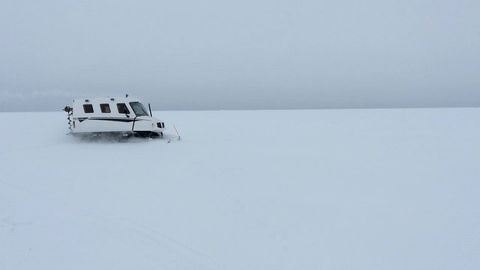A new study underway by Research Station scientists seeks a familiar objective in a unique new locale. In partnership with the Red Lake Band of Chippewa Indians, they will reconstruct the history of Upper and Lower Red Lakes – with a combined size of 288,000 acres, the largest water body entirely in the borders of Minnesota, and with a unique history and watershed – using techniques the Station’s staff developed over the past 20 years.
Extracting sediment cores from the bottom of the lake and analyzing the mud will provide essential data about the water quality and how the lake has worked for the past 200 years.
Combined with intensive water quality monitoring that the Red Lake Nation Department of Natural Resources has conducted since 1990, this work will reveal natural cycles and human impacts, to help better protect and manage the lake in the future.
“We are really interested in learning whether the nutrient dynamics of the lake have shifted since the area was settled by Europeans and using that information to establish baselines for water quality goals,” said Shane Bowe of the Red Lake Department of Natural Resources.
Comparative studies
Some of the key factors that affect the Red Lakes are shared by another current Research Station study, Lake of the Woods, 50 miles farther north. While there are similarities, such as shallow waters over the sand and clay bed of ancient Glacial Lake Agassiz and plentiful peatlands in the watershed, the Red Lakes are unusual in their condition, management, past – and solitude.
Scientists Mark Edlund and Adam Heathcote, with the assistance of Bowe and staff of the Red Lake Department of Natural Resources, made the first foray into the field in March, crossing vast expanses of ice and snow in a vehicle that looks like nothing so much as a Star Trek shuttlecraft. With only fleeting glances of a pack of timber wolves to keep them company, the lake felt as empty as deep space, too.
“Once we got off the landing, all we saw were wolves,” Mark says. “We didn’t cross a snowmobile track, or see a fish house.”
In two days, the group took cores from six locations on the lakes, racking up nearly 50 miles of travel on the ice while motoring between sites.

Two key factors that control water quality have emerged on Lake of the Woods to the north: the lingering effects of a flood of sawdust and wastewater that was dumped in the Rainy River – the lake’s largest tributary – for several decades, as well as the role of a changing climate. But the Red Lakes never had a major “pulse” of pollution in the past, providing a perfect opportunity to contrast the roles of past pollution and climate change in what Mark calls the “nastification” of large shallow lakes.
Rainfall, warmer weather, and unnatural nutrients
Understanding the effects of climate and nutrient pollution is essential if Minnesotans want healthy lakes in the decades ahead.
Also like Lake of the Woods, the Red Lakes are characterized by darkly stained water flowing out of the vast bogs of the Red Lake Peatlands. Those bogs have not historically sent much phosphorus downstream, so consequently lakes in this region may be even more susceptible to small changes in their watersheds.
“In regions like southwestern Minnesota, where lakes are already polluted with nutrients, increasing phosphorus by five parts per billion may not cause a noticeable change,” Adam says. “But in low-impact systems it may completely shift how the lakes function.”
Climate change could easily bump up the amount of phosphorus flowing out of the bog through changes in hydrology, chemistry, and organic matter decomposition.
There is only one way to find out what is going on, and it started with venturing onto the deserted ice, which Mark compared to the high Arctic landscapes where he has worked in the past.
Alone on the lakes

The first day in the field was on Lower Red Lake. The sky was blue, the ice was bright, and it was beautiful. The second day, snow started right after they set off. Pretty soon they could see only what was 100 feet in front of them. They traveled by GPS, eyes glued to the windshield, hoping they didn’t hit any invisible pressure ridges.
Besides the weather those two days, the Red Lakes also contrast with each other in another important way: the lower lake is about twice as deep as the upper. And most summers, bright green algae blooms appear on the shallower upper lake.
Depth has a complex relationship with algae and climate change. In a shallower lake, winds can more easily push waves and stir up bottom sediments. This can constantly return phosphorus to the water that had settled to the bottom.
Connecting water depth and quality
Most significantly, depth determines how lake waters separate into colder and warmer layers – with lower oxygen levels on the bottom. A shallow lake might stratify briefly several times over the course of a summer and then, when the wind picks up, the waters are mixed together, and a bunch of nutrients are brought to the sunny and fertile top waters.
The difference in average depth on the two lakes should help the scientists determine how wind and stratification work to recycle or sequester nutrients in both lakes. This could be helpful for protecting waters across the state.
“Upper and Lower Red Lakes are big shallow lakes that may be suffering the same problems that many other big shallow lakes in Minnesota have,” Mark says.
Studying these two massive and somewhat mysterious bodies of water will not only support the environmental management goals of the Red Lake Nation, but also provide valuable insights about how Minnesota’s shallow northern lakes will respond into the future.